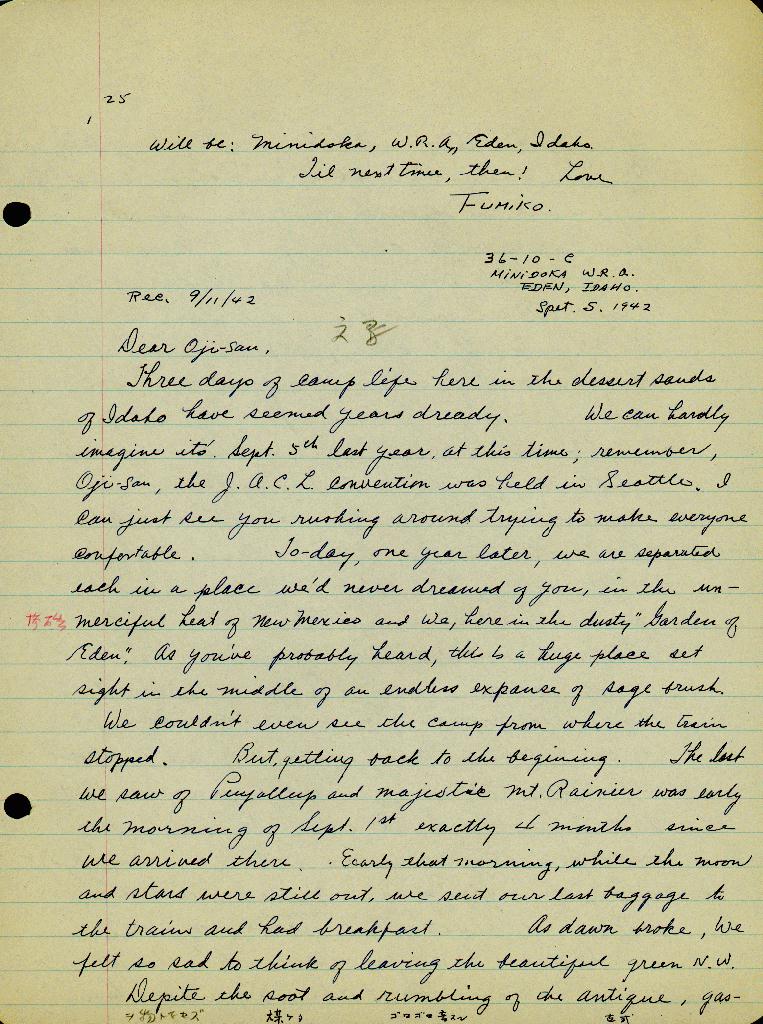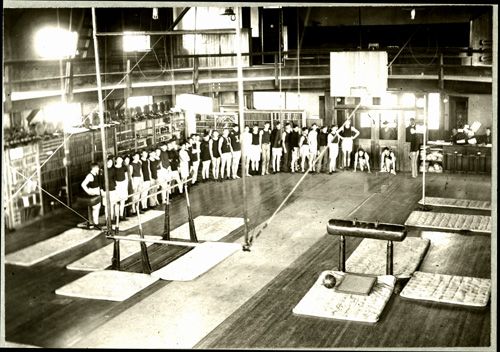


Special Collections at the University of Idaho Library offers a changing showcase of highlights from our collections. Here are the entries for 1997:
When Fumiko wrote to her Uncle George Shitamae in September 1942, the two of them were caught up in the domestic backlash of World War Two. He had been picked up in Seattle after Pearl Harbor and interned in New Mexico. After many hearings, he was not to be released until 1944. The rest of the extended family were ordered to temporary facilities at the state fairground in Puyallup. Later, they were moved to southern Idaho, a bare field north of Twin Falls at Hunt. Until a post office was established at the camp, their letters were ironically addressed from nearby Eden, Idaho.
Residents of Seattle's green and moist climate were in for shock when they arrived in the sagebrush desert of Idaho's Snake River plain. Niece Miyoko wrote of the view from the train: "The part of the trip from Puyallup down to the Dalles, Oregon was beautiful for we viewed the scenic lands around and near the Columbia River - it was lovely...but soon after we left the Dalles we saw only barren hills and flat, prairie land. Then there was the smell of sage brush and miles and miles of the uninteresting, dirty green shrub. Finally the train stopped in what we thought was the middle of this hot desert and from there we were taken in buses marked 'Sun Valley' to our home for the duration." The Minidoka Relocation Center at Hunt eventually housed 9400 people, primarily U.S. citizens who happened to be of Japanese descent.
The papers of George Shitamae covering his war-time internment were recently acquired by the University of Idaho Library through the generosity of the Library Associates of the University of Idaho Library.
Letter: Niece Fumiko to George Shihei Shitamae, September 5, 1942. George Shihei Shitamae papers, Special Collections and Archives, University of Idaho Library.

The alliance between athletics and academics, uneasy at best, is nowhere more exemplified than in this scene from the University of Idaho's early history. In March 1906, fire of suspicious origin destroyed the primary building on the university campus, the Administration Building, holding offices, classrooms, and the library. When M. Belle Sweet arrived as the University's first professionally trained librarian in 1905, the library was disorganized and inefficient. Within months, it was destroyed. The fire undid all her work in that first year and she had to begin again.
With the 738 books that had been checked out, and gifts from library supporters, friends and alumni, she started over. Miss Sweet recalled, in a 1961 interview, that:
On Monday morning after the fire the library opened in the gymnasium. Linoleum was rolled down, tables set up, a few chairs placed around, and then at night, at 4 o'clock it was turned over to the students for use as a gymnasium. They had constructed wooden bookcases on one side under the balcony and if by chance a basketball went behind the bookcase the boys went up the bookcase on the shelves, step by step and down went the books. So there would be a heap of books on the floor after the games and they had to be sorted and put back as soon as possible.
In the fall of 1907, the library was moved to the second floor of Morrill Hall, its home until the completion of the central part of the "new" Administration Building in late 1908. Miss Sweet remained in charge until her retirement in 1948, building the state's largest library for a total of 43 years.
Caption: Gymnasium and Library, 1906. #1-54-6. Historical Photograph Collection. Special Collections and Archives, University of Idaho Library.
The tropical paradise pictured on this sheet music cover is part of the tangled history of the University of Idaho's alma mater and the state song of Idaho. The music for this popular song was adapted by Alice Bessee to fit words by McKinley Helm, both University of Idaho students, for a 1917 campus song contest. Their new song, "Our Idaho," won the contest and became a regular feature of university events.
In the 1930s, after research indicated that the music was copyrighted by Sallie Hume-Douglas of Honolulu, the regents of the university contracted with the composer for permission to use the song as the alma mater. In the meantime, others had written different verses which were adopted by the state legislature in 1931 as the Idaho state song, now entitled "Here We Have Idaho."
The original McKinley Helm chorus, as it appeared in the ca. 1919 songbook, is as follows:
And here we have Idaho
Scourged on her way to fame
Silver and gold in the sunlight blaze,
And romance lies in her name.
Singing, we're singing of you,
Ah, proudly, too,
All our lives thro', we'll go
Singing, singing of you, Alma Mater, Our Idaho.
Since 1931, the second line has been rendered as "Winning her way to fame," a much less forceful expression.
Music cover: Hume-Douglas, Sallie. Garden of Paradise: Hawaiian Love Song. Special Collections and Archives, University of Idaho Library.
The town of Burke, Idaho, is geographically remote and constricted. Located seven miles up a narrow, winding canyon north of the city of Wallace, the town is 3/4 mile long and just over 300 feet wide at its center. At the time these photographs were taken, over one thousand residents lived in Burke. The lure of gold initially attracted crowds to the area. But even after gold prospects failed to pan out, people and industry continued to be drawn to the narrow canyon by rich deposits of silver and lead. Hard-rock mines, railroads, ore mills, and lumber mills all competed for limited space on the canyon floor. Restaurants, taverns, mercantiles, and other shops provided the goods and services needed to support Burke's isolated population. These busnesses also had to find building space. The town's density of people and buildings proved to be not only a construction problem, but also a safety hazard. In 1923 a fire incinerated most of the buildings in these two photographs.
While still profitable, the residents and businesses of Burke adapted to their crowded, often inhospitable, situation. Retaining walls, like the one surrounding the Hecla Mill, created some level building areas. Multi-level buildings also provided a solution to space shortages. Outhouses were built on stilts over Canyon Creek. Other buildings completely straddled the creek. By necessity, railroad tracks ran right through the center of town. Awnings on west-side shops were retracted to make room for passing trains. Burke's most famous building was the 150 room Tiger Hotel. Not only was the Tiger built over a creek, but it also had a train tunnel running through its center and a road running under its west end.
Each of these photographs is one half of a stereoscopic negative. The stereoscopic camera used to take these photos has two lenses, 2 1/2 inches apart, that simultaneously record two views of the same scene on a single negative. After a print is made, the two views are cut apart and mounted on a 3 1/2" by 7" card. Mounted this way, both images can be viewed simultaneously through a special viewer called a stereoscope. The separate images are merged by the eye into a single three-dimensional image.
These glass negatives were received in Barnard Studio envelopes but were not part of the original Barnard-Stockbridge negatives. The distant view is very similar to a larger negative in the Barnard-Stockbridge Collection. Both photographs appear to have been taken from almost the same vantage point, at slightly different times, on the same day. An early copy negative of the street scene was found among the Barnard-Stockbridge Collection. The name "Frank Hess" was affiliated with this group of glass negatives; he may have been one of the many staff photographers utilized by the Barnard Studio over the years.
Photos selected, and text written, by photograph intern Greg Schroeder.
Two views: Burke, looking north at Tiger Peak, 1903; Downtown Burke, looking south, c.1907. Special Collections and Archives, University of Idaho Library. #96-25 and #96-29.
| [U of I Library] [Catalog Search] [U of Idaho] |
|
Special Collections & Archives University of Idaho Library PO Box 442351 Moscow, Idaho 83844-2351 USA (208) 885-7951 |
|
© Copyright 2002 University of Idaho Library |